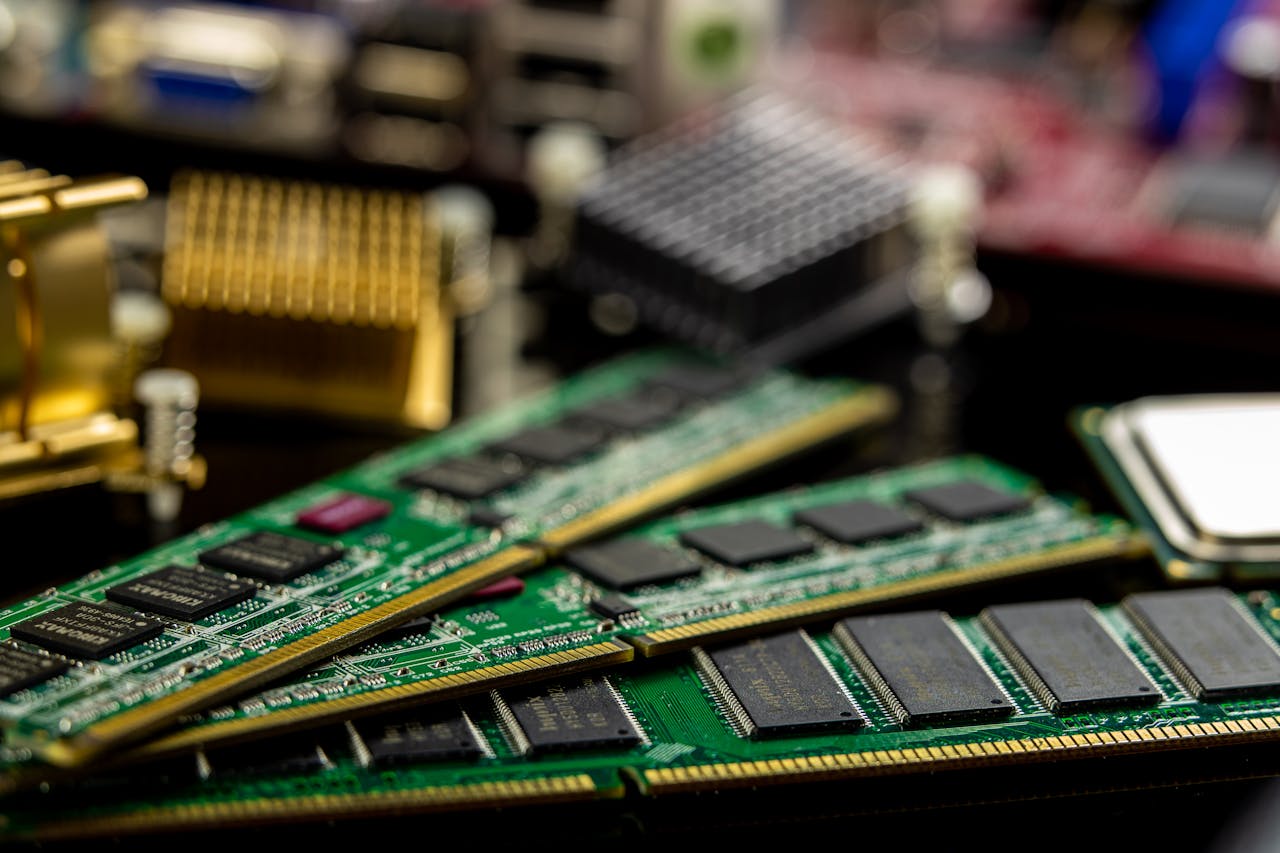How Much RAM Do I Need for Efficient Multitasking?

RAM, or Random Access Memory, plays a big role in how well our computers work, especially when we’re doing a lot of things at once. This memory helps our computer handle more tasks by storing the information it needs right away.
For multitasking and using programs that need lots of memory, knowing how much RAM you need is key. Many modern computers start with 4GB to 8GB of RAM for basic tasks. But IT experts suggest 16GB for keeping everything running smoothly without slowdowns.
For everyday use like browsing the internet or working on documents, even just 2GB might be enough. However, if you love playing games or using many applications at once, having 8GB or more can make a huge difference.
Computers with multiple screens also do better with more than 8GB of RAM.
Yet not every computer user needs to max out their machine’s memory capacity. It really depends on what you do with your computer and the specific demands of your system. Some heavy-duty users might even consider going up to 64GB! But don’t worry; adding more RAM isn’t always necessary for making your computer multitask efficiently.
Stick around to find out how much RAM suits your computing needs!
Understanding RAM and its Importance
RAM directly impacts computer performance and is crucial for efficient multitasking. Its importance lies in enabling smooth and swift transition between multiple applications.
How RAM affects computer performance
RAM plays a key role in computer performance and multitasking. The more RAM your computer has, the better it can manage multiple tasks at once. For example, with 8GB of RAM, a user can enjoy smoother transitions between task switching and keep several applications open without slowing down their system’s speed.
This makes 8GB of RAM adequate for general users who engage in day-to-day computing requirements but might be limiting for those running memory-intensive applications or heavy multitasking.
Computers designed for high-end computing or servers often come equipped with up to 32GB of RAM to handle demanding software without lag. In contrast, laptops meant for casual use may only need as little as 2GB of RAM, enough to support basic functions like internet browsing and document editing.
Upgrading to more memory enhances laptop performance significantly, allowing for seamless operation even under heavier loads such as gaming or video editing where fast memory management is crucial.
Therefore, understanding your specific memory requirements is essential when determining the right amount of RAM needed for efficient laptop performance and overall system responsiveness.
Why it is important for multitasking
Efficient multitasking demands adequate RAM to handle multiple applications simultaneously without slowing down. The right amount of RAM ensures smooth transitions between tasks, preventing lag or freezing when switching between programs.
Insufficient RAM can lead to reduced performance and productivity, hindering the seamless execution of various tasks at once. For example, running memory-intensive applications alongside everyday computing activities necessitates sufficient RAM capacity to maintain optimal speed and responsiveness.
Adequate RAM is crucial for multitasking efficiently and maintaining peak performance.
How to Determine if Your Computer Needs More Memory
Is your computer struggling to keep up with multiple tasks? Check system requirements and monitor RAM usage to assess if an upgrade is needed.
Checking system requirements
To ensure your computer can efficiently handle multitasking, check the system requirements for the RAM. The Windows operating system typically requires a minimum of 4GB of RAM to run smoothly, but efficient multitasking may demand at least 8GB or more.
If you’re using memory-intensive applications or running multiple tasks simultaneously, it’s crucial to meet or exceed these requirements to avoid performance issues and slowdowns.
Remember that different tasks have varying memory requirements, so checking the system requirements is essential before deciding on your RAM upgrade. It’s important to match your RAM with the demands of your specific usage and multitasking needs to ensure optimal performance and efficiency in handling various tasks.
Monitoring RAM usage
After checking system requirements, it’s crucial to monitor RAM usage to ensure efficient multitasking. You can do this by opening the Task Manager on Windows or Activity Monitor on Mac and observing the memory tab.
This shows how much memory is being used and by which processes, giving you insight into whether your computer needs more RAM for multitasking or memory-intensive applications. Keeping an eye on RAM usage helps in determining if an upgrade is necessary for optimal performance.
Recommended RAM for Different Tasks
For casual computer usage and internet browsing, you will need 2GB of RAM. For spreadsheets and office programs, 4GB of RAM is recommended.
Casual computer usage and internet browsing (2GB)
For casual computer usage and internet browsing (2GB), the minimum recommended RAM is 2GB. This amount is suitable for basic tasks such as web browsing, checking emails, and using productivity tools like word processors and spreadsheets.
However, it may struggle with more memory-intensive activities or running multiple applications simultaneously. As a result, users engaging in light computing tasks should be fine with the standard 2GB of RAM.
Remember that system requirements and the specific needs of an individual will influence the required amount of RAM. While 2GB is adequate for everyday use on most modern computers, multiple factors such as operating systems and background processes can affect overall performance.
Spreadsheets and office programs (4GB)
For spreadsheets and office programs, 4GB of RAM is suitable for efficient multitasking. This amount of memory allows smooth navigation between various documents and applications without experiencing lags or delays.
It provides adequate support for running spreadsheet software, word processing, email clients, and web browsing simultaneously. Users working with moderate-sized data sets in spreadsheets can comfortably work within this RAM capacity, ensuring a seamless computing experience without compromising performance.
The 4GB of RAM allocated to spreadsheets and office programs enables users to efficiently handle everyday tasks such as managing documents, creating presentations, and conducting research on the internet while seamlessly transitioning between different applications.
With this memory capacity, individuals can expect a responsive user interface when using office-based software and engaging in multitasking activities related to their professional or academic responsibilities.
Gaming and multitasking (8GB)
Moving from office tasks to more demanding activities like gaming and multitasking (8GB) requires a significant boost in RAM. For those looking to engage in seamless gameplay while simultaneously running multiple applications, 8GB of RAM is the recommended baseline.
This capacity allows for smooth functioning when switching between tasks and provides ample support for moderate multitasking needs, ensuring an optimal gaming experience without compromising system performance.
Additionally, this amount of RAM can handle modern game titles and basic multitasking requirements efficiently.
As you transition from standard office use to more dynamic activities like gaming and multitasking with 8GB of RAM, it’s essential to ensure that your computer has the necessary resources to accommodate these heavier demands seamlessly.
Memory-intensive applications (16GB)
For efficient multitasking and running memory-intensive applications, 16GB of RAM is recommended. This level of RAM allows seamless operation even when using memory-heavy software such as video editing or 3D modeling programs.
It ensures smooth performance without lagging or delays when switching between demanding tasks. With 16GB of RAM, users can experience enhanced productivity and minimized disruption during resource-intensive operations.
This amount of memory enables the computer to handle complex computational tasks efficiently, making it suitable for professionals in creative fields or those who frequently engage in heavy multitasking on their devices.
Additionally, 16GB of RAM provides ample headroom for future upgrades and expansion if computing needs grow over time.
High-end computing and servers (32GB)
High-end computing and servers often require 32GB of RAM to efficiently handle complex tasks and large datasets. Systems used for heavy computational work, virtualization, advanced simulations, and data analysis rely on high RAM capacity to ensure smooth operation.
Additionally, servers hosting multiple applications or serving a large number of users benefit from the expanded memory. The demand for 32GB stems from the need to maintain responsiveness and minimize latency in these demanding environments.
The specifications of high-end computing systems emphasize the importance of robust hardware support. In this context, 32GB of RAM plays a crucial role in ensuring seamless performance for intricate computations and concurrent operations within server environments.
Therefore, investing in adequate memory is essential for optimizing productivity and maintaining operational stability when engaging in resource-intensive tasks such as scientific research simulations or enterprise-level data processing.
Overkill or necessity? (64GB)
For most users, 64GB of RAM is overkill as it far surpasses the requirements for general multitasking and even memory-intensive applications. Only specialized tasks like high-end computing and server usage would truly benefit from such a vast amount of memory.
However, for the average user, 64GB is excessive and unnecessary.
With an average modern computer typically ranging from 4GB to 8GB of RAM, making the leap to 64GB requires a specific need or purpose that goes beyond regular multitasking or gaming.
It’s essential to consider your actual usage and only invest in this much RAM if you are routinely handling complex computational workloads that demand an exceptional level of memory capacity.
Tips for Optimizing RAM Usage
– Close unnecessary programs
– Use a RAM cleaner
Closing unnecessary programs
To optimize your RAM usage, make sure to close any unnecessary programs running in the background. This will free up memory and improve the performance of your computer. By doing this, you can ensure that the system has more resources available for tasks that require higher memory usage, such as gaming or running memory-intensive applications.
Additionally, closing unnecessary programs can prevent system slowdowns and improve overall multitasking efficiency.
Remember that closing unnecessary programs is a simple yet effective way to optimize your computer’s RAM usage and enhance its multitasking capabilities. By monitoring and controlling which programs are active, you can ensure that your computer allocates its resources more efficiently for a smoother user experience.
Using a RAM cleaner
After closing unnecessary programs, optimizing your system’s RAM usage can be achieved by using a RAM cleaner. RAM cleaners help free up memory by clearing out temporary files and processes that are no longer in use, thus improving the overall performance of your computer.
By utilizing a RAM cleaner, you can ensure that your available memory is utilized more efficiently, allowing for smoother multitasking and improved responsiveness, especially when dealing with memory-intensive applications or tasks requiring significant resources.
Keep in mind that using a RAM cleaner should be done cautiously as some tools may have limited effectiveness and potential risks if not used correctly. It’s essential to choose reputable software and follow best practices for maintaining system stability while optimizing your computer’s memory utilization.
Updating drivers and software
To optimize RAM usage, ensure to update drivers and software regularly. Outdated drivers can lead to memory leaks and reduced performance, while obsolete software may not be optimized for efficient multitasking.
By keeping everything up-to-date, you can ensure that your system utilizes its resources effectively for seamless multitasking and overall performance improvement.
Conclusion
In summary, determining the right amount of RAM for efficient multitasking is critical. With practical tips, you can optimize your computer’s performance. How will you tailor your RAM to meet your specific needs? Consider the impact that boosting your RAM could have on your overall productivity and efficiency.
Explore additional resources if you’re seeking more than just basic knowledge. Remember, efficient multitasking begins with optimizing your computer’s memory for seamless performance.
FAQs
1. What is the minimum RAM I need for efficient multitasking?
For efficient multitasking, especially with memory-intensive applications, you should aim for at least 8GB of RAM.
2. How much RAM do gamers need for good performance?
Gamers looking for smooth performance should consider having at least 16GB of RAM to handle gaming and other tasks without lag.
3. Is there a recommended amount of RAM for office tasks?
Yes, for typical office tasks like document editing and web browsing, 8GB of RAM is usually suitable to keep things running smoothly.
4. What about students? How much RAM does a student laptop need?
A student laptop should have a minimum of 8GB of RAM to ensure it can handle various educational software and multitasking efficiently.
5. Can optimizing my current RAM improve my computer’s multitasking ability?
Absolutely! Optimizing your existing RAM through proper management and closing unused applications can significantly enhance your computer’s multitasking performance without needing an upgrade.





